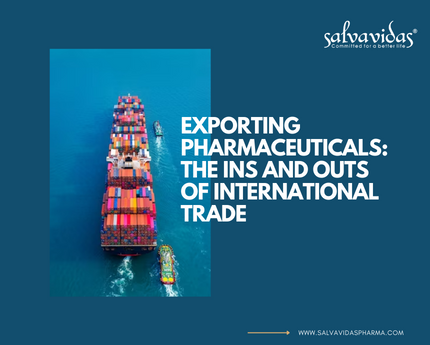
Introduction
The pharmaceutical industry is a vital part of the global economy, with an estimated worth of over $1.3 trillion in 2021. It’s no wonder that more and more companies are looking to expand their operations and reach new markets by exporting pharmaceuticals. However, the process of exporting pharmaceuticals is complex, and there are a number of regulations and considerations that need to be taken into account. In this article, we’ll provide an overview of the ins and outs of exporting pharmaceuticals, from the regulatory landscape to the logistics of shipping.
Regulatory Landscape
Exporting pharmaceuticals requires compliance with a range of regulations at the local, national, and international levels. Some of the key considerations include:
- Regulatory approvals: Before exporting pharmaceuticals, it’s essential to obtain the necessary regulatory approvals from the destination country. This typically involves obtaining a product license, which can take several months to process.
- Quality control: To ensure that pharmaceutical products meet the required quality standards, they need to be manufactured in accordance with Good Manufacturing Practice (GMP) guidelines. These guidelines outline the minimum standards for the production, testing, and release of pharmaceutical products.
- Intellectual property: Protecting intellectual property rights is essential when exporting pharmaceuticals. This includes registering patents, trademarks, and copyrights, and ensuring that your products do not infringe on the intellectual property of others.
- Data protection: Pharmaceuticals typically contain sensitive information, and it’s important to ensure that this information is protected when exporting products. This involves compliance with data protection regulations, such as the General Data Protection Regulation (GDPR) in the EU.
Logistics of Exporting Pharmaceuticals
In addition to regulatory considerations, there are a number of logistical challenges to overcome when exporting pharmaceuticals. Some of the key considerations include:
- Temperature control: Pharmaceuticals are often temperature-sensitive and need to be transported and stored at specific temperatures to maintain their efficacy. This requires careful planning and coordination to ensure that products are not exposed to temperatures that could compromise their quality.
- Packaging and labeling: Pharmaceutical products need to be packaged and labeled in accordance with local regulations. This typically involves using tamper-evident packaging and including specific information on the label, such as the name of the product, the dosage, and the expiration date.
- Shipping and customs: Exporting pharmaceuticals involves navigating a complex web of shipping and customs regulations. This includes obtaining the necessary permits and licenses, ensuring that products are correctly classified for customs purposes, and paying the relevant duties and taxes.
The global pharmaceutical industry is a rapidly growing market, worth hundreds of billions of dollars. As the demand for pharmaceuticals continues to rise, many companies are looking to expand their operations by exporting their products to other countries. However, exporting pharmaceuticals can be a complex and challenging process, with a number of rules and regulations that must be followed. In this article, we will explore the ins and outs of exporting pharmaceuticals and provide you with the information you need to get started.
Understanding the Global Market for Pharmaceuticals
The global market for pharmaceuticals is a highly competitive and lucrative industry. With the rise of new technologies and the increasing demand for new and innovative medicines, many companies are looking to expand their operations by exporting their products to other countries. However, before you can start exporting, it is important to understand the global market and the regulations that govern it.
The Regulations and Requirements for Exporting Pharmaceuticals
Exporting pharmaceuticals is a regulated industry, with a number of rules and regulations that must be followed. Some of the most important regulations include:
Good Manufacturing Practices (GMP)
Good Manufacturing Practices (GMP) are a set of guidelines that must be followed by companies in order to ensure the quality and safety of their products. These guidelines cover everything from the manufacturing process to the storage and transport of products. Companies that are exporting pharmaceuticals must be able to demonstrate that they are following GMP in order to be approved for export.
Licensing and Certification
In order to export pharmaceuticals, companies must be licensed and certified by the relevant authorities. This includes obtaining a license to manufacture pharmaceuticals and obtaining certification for the products being exported. Companies must also comply with the regulations of the countries to which they are exporting, which may include additional licensing and certification requirements.
Labelling and Packaging Requirements
Labeling and packaging requirements are important parts of exporting pharmaceuticals. Companies must ensure that their products are labeled and packaged in accordance with the regulations of the country to which they are exporting. This includes providing information about the product, such as its composition and how it should be used, as well as any warnings or precautions that may be required.
Preparing to Export Pharmaceuticals
Once you have a clear understanding of the regulations and requirements for exporting pharmaceuticals, it is time to start preparing for your export operations. Some of the key steps in preparing to export pharmaceuticals include:
Market Research
Before you start exporting, it is important to conduct market research in order to identify the countries that are most likely to be interested in your products. This research will help you to understand the demand for your products, as well as the competition and regulatory requirements in each market.
Building Relationships with Customers and Suppliers
In order to succeed in the global market, it is important to build strong relationships with your customers and suppliers. This may involve working with local distributors or agents who can help you to reach potential customers and comply with local regulations. Establishing a Quality Management System Establishing a quality management system is essential for exporting pharmaceuticals. This system should include processes for ensuring the quality and safety of your products, as well as for meeting regulatory requirements.
Conclusion
Exporting pharmaceuticals can be a complex and challenging process, but with the right preparation and understanding of the regulations, it can also be a lucrative opportunity for companies. By conducting market research, building relationships with customers and suppliers, and establishing a quality management system, companies can successfully expand their operations and succeed in the global market.
FAQ’s
Q. What is the global market for pharmaceuticals like?
A – The global market for pharmaceuticals is a highly competitive and rapidly growing industry, worth hundreds of billions of dollars. With the rise of new technologies and the increasing demand for new and innovative medicines, many companies are looking to expand their operations by exporting their products to other countries.
Q. What are the regulations for exporting pharmaceuticals?
A. Exporting pharmaceuticals is a regulated industry, with a number of rules and regulations that must be followed. This includes following Good Manufacturing Practices (GMP), obtaining licensing and certification, and complying with labeling and packaging requirements.
Q. What are Good Manufacturing Practices (GMP)?
A. GMP is a set of guidelines that must be followed by companies in order to ensure the quality and safety of their products. Companies that are exporting pharmaceuticals must be able to demonstrate that they are following GMP in order to be approved for export.
Q. What steps should a company take to prepare for exporting pharmaceuticals?
A. Some of the key steps in preparing to export pharmaceuticals include conducting market research, building relationships with customers and suppliers, and establishing a quality management system.
Q. Why is it important to establish a quality management system when exporting pharmaceuticals?
A. Establishing a quality management system is essential for exporting pharmaceuticals as it helps to ensure the quality and safety of the products, as well as to meet regulatory requirements. A well-established quality management system can also help to build trust with customers and increase the chances of success in the global market.
Salvavidas Pharmaceutical Pvt.Ltd Top Pharmaceutical manufacturing and export company in India
Contact Us:
Name: salvavidas pharmaceutical pvt. ltd
Email: info@salvavidaspharma.com
Phone No: +91 98983 21242
Address: Corp. Office #803, Shubh Square, Near Lal Darwaja, Surat, Gujarat 395004, India




0